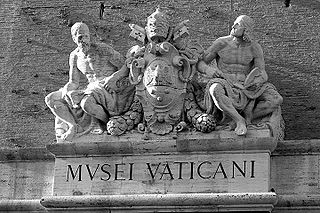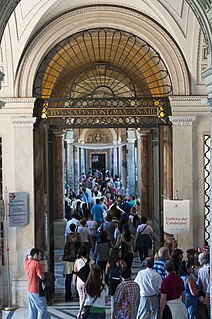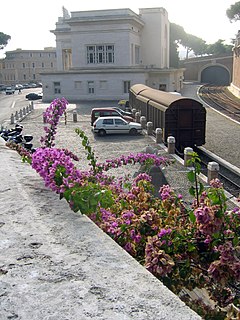Examples
- Labrum in Milan
- Labrum in Mausoleum of Theodoric in Ravenna
- Lateran Baptistery Rome
- San Bartolomeo all'Isola, Rome
- Pio-Clementino Museum Vatican
- Labrum from Baths of Caracalla Vatican museum
The labrum in architecture was a large water-filled vessel or basin with an overhanging lip. Marble labrums were a common feature of Roman thermae.

The Holy See, also called the See of Rome, is the jurisdiction of the Bishop of Rome, known as the pope, which includes the apostolic episcopal see of the Diocese of Rome with universal ecclesiastical jurisdiction of the worldwide Catholic Church, as well as a sovereign entity of international law, governing the Vatican City.

Vatican City, officially the Vatican City State, is the Holy See's independent city-state enclaved within Rome, Italy. Vatican City became independent from Italy with the Lateran Treaty (1929), and it is a distinct territory under "full ownership, exclusive dominion, and sovereign authority and jurisdiction" of the Holy See, itself a sovereign entity of international law, which maintains the city state's temporal, diplomatic, and spiritual independence. With an area of 49 hectares and a population of about 825, it is the smallest sovereign state in the world by both area and population.

The Vatican Museums are the public art and sculpture museums in the Vatican City. They display works from the immense collection amassed by the Catholic Church and the papacy throughout the centuries including several of the most renowned Roman sculptures and most important masterpieces of Renaissance art in the world. The museums contain roughly 70,000 works, of which 20,000 are on display, and currently employ 640 people who work in 40 different administrative, scholarly, and restoration departments.

Vatican Hill is a hill located across the Tiber river from the traditional seven hills of Rome, that also gave the name of Vatican City. It is the location of St. Peter's Basilica.

The Apostolic Palace is the official residence of the pope, the head of the Catholic Church, located in Vatican City. It is also known as the Papal Palace, the Palace of the Vatican and the Vatican Palace. The Vatican itself refers to the building as the Palace of Sixtus V, in honor of Pope Sixtus V, who built most of the present form of the palace.

In ancient Rome, thermae and balneae were facilities for bathing. Thermae usually refers to the large imperial bath complexes, while balneae were smaller-scale facilities, public or private, that existed in great numbers throughout Rome.

The Vatican Apostolic Library, more commonly known as the Vatican Library or informally as the Vat, is the library of the Holy See, located in Vatican City. Formally established in 1475, although it is much older, it is one of the oldest libraries in the world and contains one of the most significant collections of historical texts. It has 75,000 codices from throughout history, as well as 1.1 million printed books, which include some 8,500 incunabula.

The Lateran Palace, formally the Apostolic Palace of the Lateran, is an ancient palace of the Roman Empire and later the main papal residence in southeast Rome.

Vatican City, a quarter of a square mile (0.44 km2) in area, is a popular destination for tourists, especially Catholics wishing to see the Pope or to celebrate their faith. The main tourist attractions in Vatican City are focused in religious tourism and city tourism, including the visit to the Basilica of St. Peter, Saint Peter's Square, the Vatican Museums, the Sistine Chapel, and the Raphael Rooms.

The Vatican Railway was opened in 1934 to serve Vatican City and its only station, Vatican City. The main rail tracks are standard gauge and 300 metres (980 ft) long, with two freight sidings, making it the shortest national railway system in the world. Access to the Italian rail network is over a viaduct to Roma San Pietro railway station, and is guaranteed by the Lateran Treaty dating from 1929. The tracks and station were constructed during the reign of Pope Pius XI, shortly after the treaty.

The following outline is provided as an overview of and introduction to Vatican City:

The Tomb of the Scipios, also called the hypogaeum Scipionum, was the common tomb of the patrician Scipio family during the Roman Republic for interments between the early 3rd century BC and the early 1st century AD. Then it was abandoned and within a few hundred years its location was lost.
This is an index of Vatican City–related topics.

St Stephen of the Abyssinians is an Ethiopian Catholic church located in Vatican City. The church dedicated to Stephen the Protomartyr is the national church of Ethiopia. The liturgy is celebrated according to the Alexandrian rite of the Ethiopian Catholic Church. It is one of the only standing structures in the Vatican to survive the destruction of Old St. Peter's Basilica, and thus it is the oldest surviving church in Vatican City.
Vatican may refer to:
Rome has, for more than two millennia, been an important worldwide centre for religion, particularly the Catholic strain of Christianity. The city is commonly regarded as the "home of the Catholic Church", owing to the ecclesiastical doctrine of the primacy of the Bishop of Rome. Today, there are also other religions common in Rome, including Islam.
The Culture of Rome in Italy, refers to the arts, high culture, language, religion, politics, libraries, cuisine, architecture and fashion in Rome, Italy. Rome was supposedly founded in 753 BC and ever since has been the capital of the Roman Empire, one of the main centres of Christianity, the home of the Roman Catholic Church and the seat of the Italian Republic. Due to its historical and social importance, Rome is often nicknamed the Caput Mundi, or "capital of the world".

The Sleeping Ariadne, housed in the Vatican Museums in Vatican City, is a Roman Hadrianic copy of a Hellenistic sculpture of the Pergamene school of the 2nd century BCE, and is one of the most renowned sculptures of Antiquity. The reclining figure in a chiton bound under her breasts half lies, half sits, her extended legs crossed at the calves, her head pillowed on her left arm, her right thrown over her head. Other Roman copies of this model exist: one, the "Wilton House Ariadne", is substantially unrestored, while another, the "Medici Ariadne" found in Rome, has been "seriously reworked in modern times", according to Brunilde Sismondo Ridgway. Two surviving statuettes attest to a Roman trade in reductions of this familiar figure. A variant Sleeping Ariadne is in the Prado Museum, Madrid. A later Roman variant found in the Villa Borghese gardens, Rome, is at the Louvre Museum.
Vatican City has become one of the world's most striking architecture through several centuries and a world cultural heritage. The area of the Vatican is small, which is made up of several famous landmarks. The architecture of Vatican City, dominated by religious architecture, is characterized by several architectural styles such as Roman, Baroque, and Gothic with the different time, most representative the buildings are concentrated in the medieval period and the 16th–18th century.
| This architecture-related article is a stub. You can help Wikipedia by expanding it. |